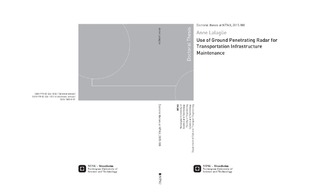| dc.contributor.author | Lalagüe, Anne | |
| dc.date.accessioned | 2015-11-24T12:08:06Z | |
| dc.date.available | 2015-11-24T12:08:06Z | |
| dc.date.issued | 2015 | |
| dc.identifier.issn | 1503-8181 | |
| dc.identifier.uri | http://hdl.handle.net/11250/2365442 | |
| dc.description.abstract | Routine inspection of transportation infrastructure is an essential component of
maintenance and rehabilitation programs. However, it often necessitates a
significant amount of work and resource allocation. In this study, the feasibility of
the Ground Penetrating Radar (GPR) technology to assess and monitor the condition
of infrastructure is investigated.
The thesis first introduces the basic principles of GPR, its advantages and
limitations. The technology, based on the propagation of electromagnetic waves, has
the ability to penetrate surfaces and see what is behind. The detection of hidden and
underground objects depends on the contrast in the dielectric properties between
the surveyed object and the traversed medium. In addition to being non-destructive,
GPR has unique advantages such as the rapidity and continuity of measurements.
However, traditional obstacles are conductive environments, the cost of data
collection, and a relative complexity of data interpretation.
After a comprehensive background research, laboratory and field testing, the main
conclusions of this thesis are:
The step-frequency GeoScope GPR, currently the only system available in Norway
for infrastructure surveys, is a very accurate instrument. The error in GPR readings
for pavement thicknesses is evaluated to 3,3 %, in line with other published studies.
However, as for ground-coupled antennas, it requires more calibration effort with
coring than air-coupled models that can calculate the dielectric permittivity
continuously.
As a general rule, the accuracy of GPR systems is affected by the interpretation
process of the collected data. Best results are obtained from manual interpretation.
Semi-automatic layer tracking tools are time-saving but may increase inaccuracies
in data analysis.
GPR is well-suited for geological inspections in tunnels, especially in remotely
mapping the cavity behind concrete linings. The distance to the bedrock is very
accurately determined since the thickness of the concrete walls is generally known
and the dielectric permittivity of air is constant (ε = 1). Ground-coupled antennas
are also found to be effective in detecting loose rocks that have fallen from the tunnel
roof onto the concrete lining. Such surveys may help detect early signs of rock
instability. Given the number of tunnels in Norway and type of construction, the use
of GPR can ultimately result in improved tunnel evaluation and considerable cost
savings.
In the light of the recent focus on environmental damages caused by salt, it is of
interest to examine the ability of GPR to measure remaining salt on winter roads.
Preliminary results are encouraging and indicate that the technology could have the
potential to address this need. A research approach consists in establishing a
relationship between GPR amplitudes and salt quantities. In that respect, the
accuracy of the salt measurement device SOBO-20 and the water retention
characteristics of pavements (not included in this thesis) are studied. However,
further investigations of these issues are beyond the scope of this PhD thesis and are
not researched.
Other applications of GPR in Norway are forensics studies related to frost heave of
soils and pavements, and condition assessment of concrete airfields. The conclusion
that emerges from this PhD thesis is that Ground Penetrating Radar can be used in
various ways across many fields of engineering. Some applications have undergone
great development worldwide, while others are innovative and relevant to
Norwegian distinctive specificities. It is hoped that this PhD work will contribute to
both research and implementation of the GPR technology in Norway. | nb_NO |
| dc.language.iso | eng | nb_NO |
| dc.publisher | NTNU | nb_NO |
| dc.relation.ispartofseries | Doctoral thesis at NTNU;2015:188 | |
| dc.relation.haspart | Paper 1: Lalagüe, Anne; Hoff, Inge; Eide, Egil; Anders, Svanekil. Use of Ground Penetrating Radar for Detection of Salt Consentration on Norwegian Winter Roads. The eight International Conference on the Bearing Capacity of Roads and Airfields.; 2009 | nb_NO |
| dc.relation.haspart | Paper 2: Lalagüe, Anne; Hoff, Inge. Accuracy of Ground Penetrating Radar in Bituminous Pavement Thickness Evaluation. Transport Research Arena; 2010 | nb_NO |
| dc.relation.haspart | Paper 3: Lalagüe, Anne; Hoff, Inge. Determination of space behind pre-cast concrete elements in tunnels using GPR. 13th Conference on Ground Penetrating Radar; 2010
<a href="http://dx.doi.org/ 10.1109/ICGPR.2010.5550195" target="_blank"> http://dx.doi.org/10.1109/ICGPR.2010.5550195 </a>
(c) 2010 IEEE. Personal use of this material is permitted. Permission from IEEE must be obtained for all other users, including reprinting/ republishing this material for advertising or promotional purposes, creating new collective works for resale or redistribution to servers or lists, or reuse of any copyrighted components of this work in other works. | nb_NO |
| dc.relation.haspart | Paper 4: Lalagüe, Anne; Gryteselv, Dagfin; Hoff, Inge. Bearing capacity of airfield pavements – In situ survey, measurements and calculations using GPR and FWD. I: Proceedings Ninth International Conference on the Bearing Capacity of Roads, Railways and Airfields - Volume 1.s. 133-142 | nb_NO |
| dc.relation.haspart | Paper 5: Lysbakken, Kai Rune; Lalagüe, Anne. Accuracy of SOBO 20 in the measurement of salt on winter pavements. Transportation Research Record 2013 ;Volum 2329. s. 24-30 - Is not included due to copyright available at
<a href="http://dx.doi.org/ 10.3141/2329-04" target="_blank"> http://dx.doi.org/10.3141/2329-04 </a> | nb_NO |
| dc.relation.haspart | Paper 6: Lalagüe, Anne; Lebens, Matthew A. and Hoff, Inge Accuracy of Ground Penetrating Radar in Pavement Thickness Evaluation – Impact of Interpretation Errors. Presented at the 7th Transport Research Arena, 2014. | nb_NO |
| dc.relation.haspart | Paper 7: Lalagüe, Anne; Lebens, Matthew A.; Hoff, Inge; Grøv, Eivind Detection of Rock Fragments on Tunnel Concrete Lining with Ground Penetrating Radar (GPR) | nb_NO |
| dc.title | Use of Ground Penetrating Radar for Transportation Infrastructure Maintenance | nb_NO |
| dc.type | Doctoral thesis | nb_NO |
| dc.subject.nsi | VDP::Technology: 500::Building technology: 530::Building, construction and transport technology: 532 | nb_NO |

